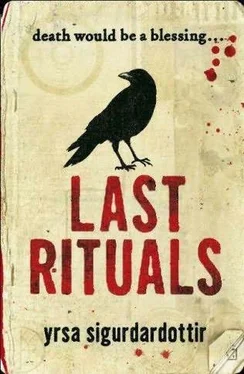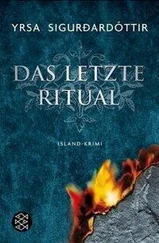The final document in this section was a printout from the university listing student societies and student publications in various departments. Scanning the list, Thora noticed nothing interesting until the bottom of the page: "Malleus MaleficarumHistory and Folklore Society." Thora looked up from the folder. This was the same name that was on the photocopy of the agenda from the founding meeting during Harald's student days in Munich. She flicked back through the pages to check. Beneath the name of the society on the Icelandic list was written in pencil: "errichtet 2004" founded 2004. This was after Harald enrolled at the university in Iceland. Could its establishment have been his idea? This was not unlikely, unless Malleus Maleficarum was particularly symbolic for history and folklore. Of course, it could mean anything; Thora knew no Latin to speak of. She moved on to section five, his bank accounts.
This was a thick pile of statements from a foreign bank account. Harald Guntlieb was listed as the holder and his turnover looked enormous at first glance, although little was left in the account at the end of the last period. Several entries had been highlighted with a marker pen: pink for large withdrawals and yellow for large deposits. Thora quickly noticed that the yellow entries were always the same amount, deposited at the beginning of each month. It was a hefty sum, more than she made in half a yeareven a busy one. These must be payments from the trust Matthew said Harald had inherited from his grandfather. It was likely that the inheritance was allocated as regular payments to Harald rather than as a lump sum. This was the most common arrangement for young heirs until a certain age was reached, depending on their reliability. Harald Guntlieb had clearly not been considered very responsible, since, according to Thora's calculations, he was twenty-seven when he died but still had not been entrusted with the principal. However, considerable sums had accumulated in the account, and Harald's basic living expenses were obviously way below his monthly allowance.
The highlighted withdrawals were a completely different matter. They varied in amount and were made at irregular intervals as far as Thora could see. Notes had been written beside most of them, and since there were not so many, Thora browsed them all. She understood some of the remarks immediately, such as "BMW" beside a large withdrawal in the beginning of August 2004, when she assumed he had bought a car in Iceland. Others she could not make head or tail of. "Urteil G.G.," for example, was written alongside a hefty withdrawal from Harald's student days in Munich. Since Urteil means "ruling," she had a hunch that Harald had needed to pay someone to conceal the reason for his dismissal from the army. However, the date did not fit and she could not imagine what G.G. meant. In another place was Schadel, "skull," and elsewhere Gestell, which stumped her. She found more withdrawals with no context and decided not to waste her time on them.
Two entries caught her attention, however. The first, several years old and amounting to 42,000 euros, was yet again designated by the Latin term " Malleus Maleficarum, " while the much more recent one had a question mark beside it. This was presumably the money Matthew said had gone missing, just over 310,000 euros. Thora calculated this to be more than twenty-five million Icelandic kronur. No wonder Matthew doubted the money had been spent on drugs. If it had, Harald would have had his work cut out for him, even if Keith Richards had been around to help. And judging from the bank statements it also appeared that Harald was not short of money, in spite of such large withdrawals.
She moved on to the next page, which showed Harald's credit card use in the months before his death. Scanning through them, she saw that the majority of the charges were to restaurants and bars, with the occasional purchase in clothing stores. The restaurants could all be categorized as what Thora's friend Laufey would call "trendy." Noticeably few transactions were made in grocery stores. A large sum spent at Hotel Ranga in mid-September caught Thora's eye, as did another marked "School of Aviation" and a much smaller charge from the Reykjavik family zooof all placesdated at the end of September. There were also a number of small purchases in a pet shop on the outskirts of the capital. Maybe Harald liked animals or had even been trying to impress a single mother by gaining her children's approval. Yet another point to ask Matthew about. The section on Harald's finances ended with these statements. Thora looked at her watch and saw that she was making good progress.
Thora decided to take a rest from the folder. She turned to her computer and Googled "Malleus Maleficarum." More than fifty-five thousand results came back. She soon found one that looked promising, with a page description saying that the phrase meant "Witches' Hammer" and was the title of a book from 1846. Thora clicked the link and a site came up in English. The only graphics on the page were an ancient drawing of a woman in a cowl, apparently tied to a ladder. Two men were struggling to lift up the ladder and roll it, along with the woman, into a great fire blazing in front of them. She was clearly being burned alive. The woman looked heavenward, her mouth open. Thora could not tell whether the artist intended to depict her beseeching God or cursing him. But her desperation was obvious. Thora printed out the page and went to fetch it before Bella removed it from the printer. That girl was capable of anything.
There turned out to be five sheets of paper in the printer, not one as Thora had expected. The Web site actually contained much more than just a single screen's worth, and Thora began reading the pages on her way back to her office.
The brief introductory paragraph stated that Malleus Maleficarum was undoubtedly one of the most notorious books ever written. First published in 1486, it was intended as a manual to teach inquisitors how to recognize, prosecute, and execute witches. It emphasized that black magic and various customs of the common people were now considered blasphemy, which was punishable by death at that timepractitioners were burned at the stake. The book was divided into three parts, according to the article. The first was aimed at making people realize that magic and witchcraft were real phenomena, and also that these were considered evil and unnatural. It stated that the mere act of believing in the existence of the black arts was blasphemous, which was a new ruling. Section two was a compendium of lurid tales about witches' practices, dominated by sex with demonic beings. The third and final section laid down the foundation for prosecuting witches. It underlined that torture was a permissible means of extracting confessions and everyone was allowed to testify against those accused of such crimes, irrespective of reputation or other normal standards for deeming witnesses unfit or partial.
The authors of the text were said to be two Dominican Black Friars: Jakob Sprenger, at that time chancellor of the University of Cologne, and Heinrich Kramer, professor of divinity at the University of Salzburg and chief inquisitor in Tyrol. The latter was credited with authoring the majority of the text, as he had been extensively involved in prosecuting witches ever since 1476. The work was reputedly written at the urging of Pope Innocent VIII, who did not appear to be a particularly attractive character according to this account. He was attributed with starting the witch hunts in Europe by issuing the papal bull of December 5, 1484, titled Summus desiderantes affectibus, authorizing the Inquisition to prosecute witches and equating sorcery with blasphemy.
Читать дальше












